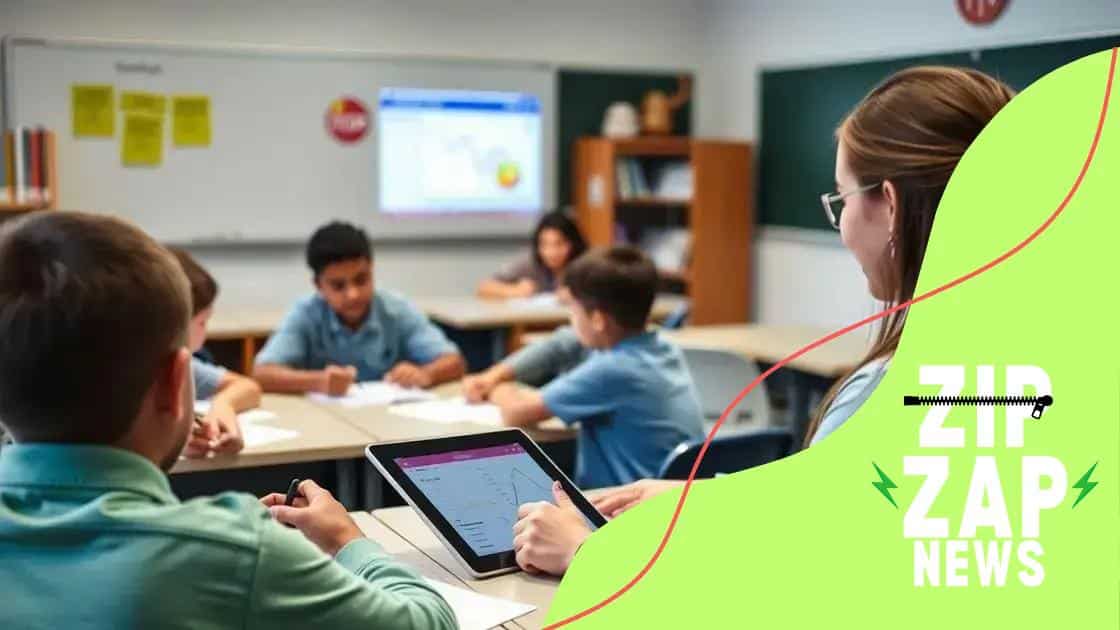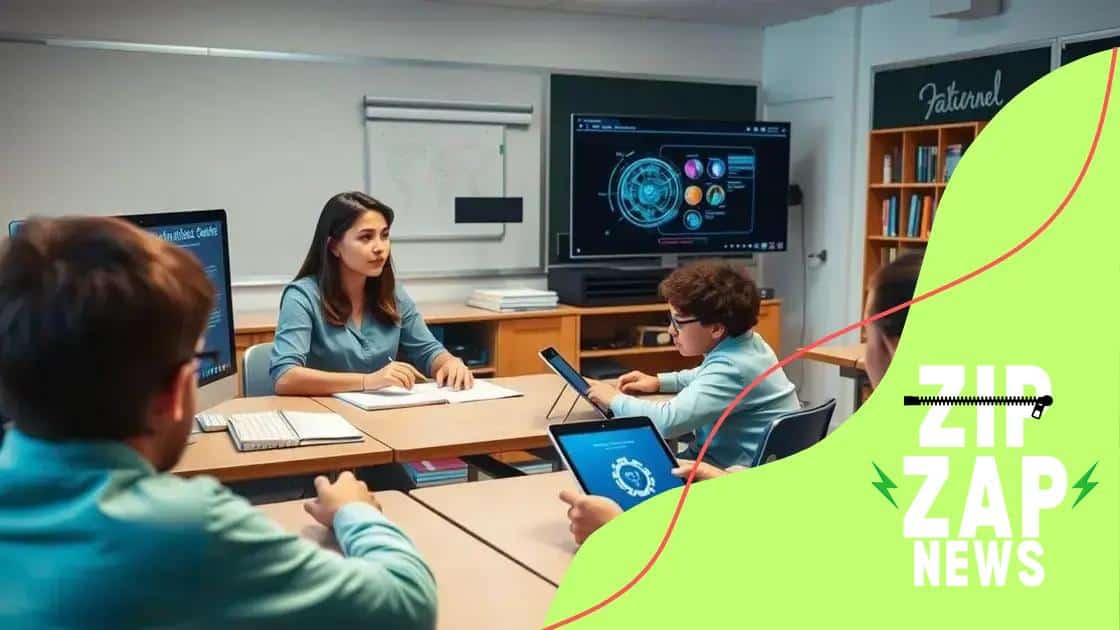AI tools for student progress monitoring: Enhance learning

AI tools for student progress monitoring enhance personalized learning by providing instant feedback, tracking performance, and adapting assessments to individual needs, resulting in improved educational outcomes.
AI tools for student progress monitoring are changing the game in education. Have you ever wondered how technology can help teachers understand their students better? In this article, we explore the impact of these innovative tools on learning.
Overview of AI tools in education
Artificial Intelligence (AI) tools are making a significant impact in education today. These tools offer ways to enhance learning experiences, making them more effective for both teachers and students. By integrating AI, educators can streamline tasks and focus on what truly matters—student engagement.
Types of AI Tools
There are several categories of AI tools used in education:
- Learning Management Systems: Platforms that use AI to personalize learning content based on student performance.
- Grading Software: Tools that can assess student work automatically, providing quick feedback.
- Virtual Tutors: AI-driven systems that offer support and tutoring to students outside the classroom.
- Analytics Platforms: Tools that analyze learning data to provide insights into student progress.
These tools can provide more personalized learning experiences, helping students learn at their own pace. For instance, a learning management system can adapt lessons according to a student’s strengths and weaknesses. It’s like having a tailor-made education designed just for you!
Benefits of Using AI Tools
AI tools have numerous benefits for educational settings. They can save time and resources by automating routine tasks. Teachers can dedicate more time to interacting with students rather than focusing solely on administrative tasks. Additionally, these tools enrich the learning environment, offering innovative ways for students to engage with the material.
Imagine a classroom where each student is working on problems tailored specifically for them! AI makes this possible. By utilizing data, educators can identify gaps in knowledge and address them immediately.
Overall, the integration of AI tools in education is not just about technology; it’s about improving the learning process for everyone involved. Educators gain valuable insights, and students receive personalized attention, making learning more engaging and effective.
Key benefits of AI in monitoring progress
AI plays a crucial role in monitoring student progress, bringing many benefits to the educational system. With AI tools, teachers can gain valuable insights into how their students are performing, which helps them tailor their instruction methods.
Individualized Learning
One major advantage is the ability to provide individualized learning paths for students. When using AI, educators can track what topics a student struggles with and adjust lessons accordingly. This ensures that each learner receives the support they need.
- Personalized Feedback: AI gives students immediate feedback on assignments, helping them understand concepts better.
- Data-Driven Decisions: Teachers can make informed decisions based on real-time data about student performance.
- Identifying Trends: AI helps identify trends in learning behaviors, allowing for timely interventions.
Another benefit is the increase in efficiency. Teachers often spend a lot of time grading assignments and assessing student understanding. AI tools can automate these processes, allowing educators to focus on teaching rather than paperwork.
Enhanced Engagement
AI also enhances student engagement. By using gamification and interactive content, students are more likely to be interested and motivated in their learning. This engagement leads to better retention of information and overall improvement in academic performance.
As students become more engaged, AI systems can adapt to their changing needs, ensuring a tailored educational experience. This dynamic approach keeps learners on the right track and encourages a love for learning.
Ultimately, integrating AI in monitoring progress not only improves student outcomes but also lessens the burden on teachers, creating a better learning environment for everyone.
How AI tools aid personalized learning

AI tools play a vital role in enhancing personalized learning experiences for students. With the right AI solutions, education becomes more adaptable, meeting the unique needs of each student.
Tailored Learning Paths
One of the key features of AI is its ability to create tailored learning paths. By analyzing student data, AI systems can identify strengths and weaknesses. This allows educators to design courses that fit individual learning styles. For instance, some students may need more practice with certain topics, while others may progress quickly through the material.
- Adaptable Lessons: Lessons can be adjusted in real-time based on student performance.
- Customized Resources: Educators can provide resources that specifically target a student’s needs.
- Flexible Pacing: Students can learn at their own pace, reducing frustration and increasing enjoyment.
Moreover, AI tools help in keeping students engaged. Interactive learning modules powered by AI can make challenging topics more enjoyable. Games and simulations are examples of how AI can turn traditional lessons into interactive experiences that hold students’ interest.
Real-Time Feedback
Another significant benefit is the provision of real-time feedback. AI tools can assess student responses instantly, helping them understand their mistakes and learn from them quickly. This prompt feedback loops in learning, encouraging students to improve continuously.
Additionally, AI can help teachers identify which students may require extra help. With analytics capabilities, educators can see patterns in classroom performance, allowing for targeted interventions when necessary. This ensures that no student falls behind.
Overall, the integration of AI tools into educational settings transforms the way students learn. With personalized approaches, learning becomes more effective, engaging, and ultimately rewarding for both students and educators.
Challenges in implementing AI tools
Implementing AI tools in education comes with various challenges. Schools and educators often face obstacles that can hinder the successful integration of technology into the classroom.
Cost and Resources
One significant challenge is the cost associated with acquiring and maintaining AI tools. Many schools have limited budgets, making it difficult to invest in the latest technologies. This financial strain can also extend to training staff effectively.
- Funding Limits: Schools often struggle with securing funds for new technology.
- Training Needs: Teachers may require extensive training to effectively use AI tools.
- Maintenance Costs: Ongoing support and maintenance can add to the initial expense.
Another noteworthy challenge involves data privacy. Educators must ensure that student data is protected and used appropriately. This concern grows as AI systems often rely on student data to personalize learning experiences.
Resistance to Change
Resistance from staff and administration can also be a barrier. Some educators may be hesitant to adopt new technologies, preferring traditional methods of teaching. Overcoming this resistance is essential to fully realize the potential benefits of AI tools.
Additionally, the implementation timeline can be lengthy. Schools may take significant time to integrate AI into their existing systems. Lack of clear communication and planning can further complicate the process, leading to frustration among teachers and students.
Ensuring equitable access to AI tools is another ongoing challenge. Not all students have the same level of access to technology, which creates disparities in learning opportunities. Schools must find ways to provide support to all students, regardless of their background.
In summary, while the benefits of AI tools in education are clear, the challenges associated with their implementation also need to be addressed to ensure success.
Future trends in AI for student assessment
The future of AI in student assessment looks promising. Educators are increasingly looking for ways to enhance the evaluation process using artificial intelligence. This technology is transforming how we assess student knowledge and skills.
Automated Assessments
One significant trend is the rise of automated assessments. AI can quickly evaluate student work, providing instant feedback. This not only saves time for teachers but also helps students improve their understanding in real time. With machine learning algorithms, these systems can identify common mistakes and suggest tailored resources.
- Efficient Grading: AI can handle large volumes of tests, ensuring consistency in grading.
- Personalized Learning Feedback: Students receive specific feedback based on their performance.
- Fewer Biases: AI helps reduce human error and biases in scoring.
Additionally, AI tools are becoming more sophisticated in analyzing student performance data. They can track progress over time and identify learning trends. This allows educators to adapt their teaching methods to better meet the needs of their students.
Dynamic Assessments
A shift toward dynamic assessments is also emerging. Unlike traditional tests, these assessments adapt to the student’s knowledge level. As students answer questions correctly, the difficulty increases, ensuring they are always challenged.
This method provides a more accurate measure of a student’s abilities. It mimics real-world scenarios where individuals must apply their knowledge in various situations. The flexibility of AI allows assessments to be engaging and comprehensive.
Furthermore, as technology advances, AI systems are expected to incorporate real-time feedback loops. This means assessment tools will not only evaluate understanding but also teach and reinforce concepts simultaneously. By interacting with assessments, students can learn while being tested.
In conclusion, the integration of AI in student assessment is paving the way for more engaging, efficient, and personalized learning experiences. As schools embrace these technologies, the future of education continues to evolve, aiming to improve student outcomes.
AI tools are revolutionizing the way we monitor and assess student progress. These innovations make learning more personalized and engaging. As schools adopt these technologies, they improve learning outcomes and help teachers focus on what really matters: supporting their students. Embracing AI in education not only enhances assessment methods but also paves the way for a brighter future in learning. With ongoing technological advancements, the potential for using AI effectively in education will continue to grow, making learning enjoyable and effective for everyone involved.
FAQ – Frequently Asked Questions About AI Tools in Education
How do AI tools personalize student learning?
AI tools analyze student performance data and adapt lessons to fit individual needs, ensuring each student receives the support they require.
What are the benefits of automated assessments?
Automated assessments save teachers time by quickly grading assignments and providing instant feedback, allowing for more efficient learning.
How can AI help in tracking student progress?
AI helps track student progress by analyzing data over time, identifying trends, and providing teachers with valuable insights to enhance instruction.
What challenges do schools face when implementing AI tools?
Challenges include costs, data privacy concerns, resistance to change from staff, and ensuring equitable access to technology for all students.





